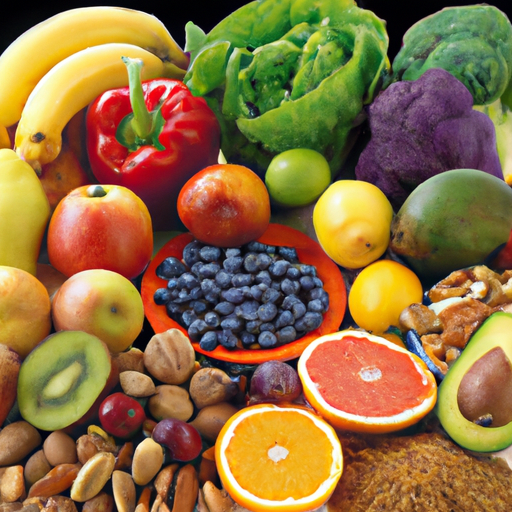Are you looking to optimize your digestive health? Fiber plays a crucial role in maintaining a balanced diet, but it’s important to note that a high-fiber diet isn’t suitable for everyone. Fortunately, there are plenty of easy-to-digest foods that you can incorporate into your meals. Options like white rice, bananas, sweet potatoes, applesauce, white bread, yogurt, melons, squash, oatmeal, and lean animal proteins are all gentle on the stomach and promote regularity. Additionally, adjusting your fiber intake, hydrating properly, exercising regularly, prioritizing sleep, and managing stress levels can all contribute to better digestion. By making these simple changes, you can achieve optimal health and a happier digestive system.

The Importance of Fiber in a Balanced Diet
What is fiber?
Fiber, also known as dietary fiber or roughage, is a type of carbohydrate that is not easily digested by the body. It is found mainly in plant-based foods such as fruits, vegetables, whole grains, legumes, nuts, and seeds. Unlike other carbohydrates, fiber passes through the digestive system without being broken down and absorbed.
Functions of fiber in the body
Fiber plays a crucial role in maintaining a healthy digestive system and overall well-being. It offers several key benefits, including:
-
Promoting bowel regularity: Fiber adds bulk to the stool, making it easier to pass through the intestines and preventing constipation.
-
Preventing hemorrhoids: Hemorrhoids, which are swollen blood vessels in the rectum and anus, can be caused by straining during bowel movements. Fiber softens the stool and reduces the need for straining.
-
Controlling blood sugar levels: Soluble fiber slows down the absorption of sugar in the bloodstream, helping to regulate blood sugar levels and reduce the risk of developing type 2 diabetes.
-
Lowering cholesterol levels: Soluble fiber binds to cholesterol in the digestive system, preventing it from being absorbed into the bloodstream. This can help reduce levels of LDL (bad) cholesterol and lower the risk of heart disease.
-
Promoting a healthy weight: High-fiber foods tend to be more filling and satisfy hunger for longer periods, which can aid in weight management by reducing calorie intake.
-
Supporting gut health: Fiber acts as a prebiotic, providing nourishment to the beneficial bacteria in the gut. These bacteria help maintain a healthy balance in the digestive system and support overall immune function.
High-Fiber Diet: Pros and Cons
Benefits of a high-fiber diet
For most people, a high-fiber diet offers numerous health benefits. These include:
-
Improved digestion: High-fiber foods help prevent constipation by adding bulk to the stool and promoting regular bowel movements.
-
Weight management: Foods high in fiber are often more filling, which can reduce appetite and prevent overeating.
-
Reduced risk of chronic diseases: High-fiber diets have been associated with a lower risk of heart disease, stroke, type 2 diabetes, and certain types of cancer.
-
Lower cholesterol levels: Soluble fiber can help lower LDL cholesterol levels, reducing the risk of developing heart disease.
-
Better blood sugar control: Fiber slows down the absorption of sugar, preventing blood sugar spikes and aiding in the management of diabetes.
Potential drawbacks of a high-fiber diet
While a high-fiber diet is generally beneficial, it may not be suitable for everyone. Some potential drawbacks include:
-
Digestive discomfort: A sudden increase in fiber intake can cause bloating, gas, and stomach cramps. It’s important to gradually increase fiber consumption to allow the digestive system to adjust.
-
Interference with medication absorption: Fiber can bind to certain medications and reduce their effectiveness. It is advisable to take medications separately from high-fiber foods or consult a healthcare professional for guidance.
-
Risk of nutrient deficiencies: High-fiber diets may displace other nutrient-rich foods, leading to potential deficiencies in vitamins, minerals, and protein. It’s important to ensure a well-balanced diet and consult with a healthcare professional if concerned.
Easy-to-Digest Foods
Characteristics of easy-to-digest foods
Easy-to-digest foods are those that are gentle on the digestive system and are less likely to cause digestive issues such as bloating, gas, or discomfort. These foods are typically low in fiber and easy to break down and absorb. Some characteristics of easy-to-digest foods include:
-
Low in fiber: Foods that are low in fiber are easier to digest because they require less work from the digestive system.
-
Soft and tender: Foods that are soft and tender are easier for the stomach to break down and digest.
-
Cooked or processed: Cooking or processing foods can make them easier to digest by breaking down complex carbohydrates and proteins.
10 easy-to-digest foods
-
White rice: White rice is easily digestible and gentle on the stomach, making it a good option for those with digestive sensitivities.
-
Bananas: Bananas are soft and contain natural enzymes that aid in digestion. They can also help alleviate both constipation and diarrhea.
-
Sweet potatoes: Sweet potatoes are rich in nutrients and easier to digest compared to white potatoes. Their natural sugars are broken down more slowly, providing sustained energy.
-
Applesauce: Applesauce is low in fiber and can be easily tolerated by those with digestive issues or sensitive stomachs. It is gentle on the digestive tract and can help soothe an upset stomach.
-
White bread: White bread is less fibrous than whole grain bread and is easier to digest. Opting for softer, more refined bread can be beneficial for those with digestive concerns.
-
Yogurt: Yogurt is a good source of protein, calcium, and beneficial bacteria. It lacks fiber and is generally well-tolerated by those with digestive sensitivities.
-
Melons: Melons, such as watermelon and cantaloupe, have high water content and are low in fiber. They are refreshing and easy to digest, making them a good choice for those with sensitive stomachs.
-
Squash: Squash is a nutrient-rich vegetable that is easy to digest. It is recommended for individuals with irritable bowel syndrome (IBS) who are looking for easy-to-digest options.
-
Oatmeal: Instant oats have the least amount of fiber among oat varieties and can be easily paired with other easy-to-digest foods. They provide a warm and soothing option for breakfast or snacks.
-
Chicken and turkey: Lean animal proteins like chicken and turkey are easier to digest compared to fatty meats. They provide high-quality protein without excessive fat, making them a good choice for those with digestive sensitivities.

White Rice: A Safe Starch for Athletes
Why is white rice a good option for athletes?
White rice is often considered a “safe starch” for athletes due to its high carbohydrate content and ease of digestion. During physical activity, the body requires a steady supply of energy, and white rice provides a readily available source of carbohydrates that can be quickly broken down and absorbed.
Unlike brown rice, which retains its bran and germ layers, white rice is milled and polished, removing those layers along with most of the fiber content. This makes white rice easier to digest, as it puts less strain on the digestive system, allowing athletes to comfortably fuel their bodies before, during, and after exercise.
Benefits of white rice for digestion
White rice is easily digested because it is low in fiber and contains simple carbohydrates that are quickly broken down into glucose. This makes it gentle on the stomach and less likely to cause digestive discomfort or bloating.
Athletes often rely on white rice as a primary source of carbohydrates because it provides a quick energy boost without causing digestive issues. It can be easily paired with lean proteins, vegetables, and healthy fats to create a well-rounded meal that supports optimal digestion and performance.
Bananas: Improvements in Digestive Health
Effects of bananas on constipation
Bananas are known for their potential to relieve constipation and promote regular bowel movements. They contain soluble fiber, which absorbs water and adds bulk to the stool, helping to stimulate bowel movements.
Additionally, bananas contain natural sugars such as fructose, which can have a mild laxative effect when consumed in moderate amounts. This can help soften the stool and make it easier to pass through the digestive system.
Effects of bananas on diarrhea
Bananas are also effective in alleviating diarrhea. They contain a type of fiber called pectin, which helps bind loose stools and create firmer bowel movements. This can help reduce the frequency and urgency of diarrhea episodes.
Furthermore, bananas contain electrolytes such as potassium, which are often lost during episodes of diarrhea. Consuming bananas can help replenish these electrolytes and promote hydration, aiding in the recovery from diarrhea and restoring balance to the digestive system.
Sweet Potatoes: Gentle on the Digestive Tract
Why are sweet potatoes gentle on the digestive tract?
Sweet potatoes are a great option for those with digestive sensitivities or conditions such as irritable bowel syndrome (IBS). They are considered gentle on the digestive tract due to several reasons:
-
Low in FODMAPs: Sweet potatoes are low in fermentable oligosaccharides, disaccharides, monosaccharides, and polyols (FODMAPs). These are a group of carbohydrates that can cause digestive symptoms in some individuals.
-
High in fiber: While sweet potatoes do contain fiber, it is primarily insoluble fiber, which adds bulk to the stool without causing excessive gas or bloating.
-
High water content: Sweet potatoes have a high water content, which helps prevent dehydration and promote regular bowel movements.
-
Nutrient-rich: Sweet potatoes are packed with essential vitamins, minerals, and antioxidants, providing nourishment without putting strain on the digestive system.
Promoting regularity with sweet potatoes
Sweet potatoes can help promote regularity in the digestive system due to their high fiber content and ability to add bulk to the stool. This can be particularly beneficial for individuals with constipation or irregular bowel movements.
Additionally, the natural sugars in sweet potatoes are broken down more slowly, providing a steady release of energy. This can help maintain stable blood sugar levels and prevent spikes and crashes, which can negatively impact digestion.
Applesauce: Low-Fiber Option for Gastroparesis
Recommended diet for gastroparesis
Gastroparesis is a condition characterized by delayed emptying of the stomach, leading to symptoms such as nausea, vomiting, and bloating. Individuals with gastroparesis often benefit from a low-fiber diet that is easy to digest.
A recommended diet for gastroparesis typically includes foods that are low in fiber, fat, and roughage. These foods should be well-cooked, soft, and easily chewed. Foods that are high in fiber, such as whole grains, raw fruits and vegetables, and legumes, should be avoided or consumed in small quantities.
Benefits of applesauce in gastroparesis
Applesauce is a popular choice for individuals with gastroparesis due to its low-fiber content and ease of digestion. It is made by cooking and pureeing apples, removing their skins and most of the fiber.
The smooth texture of applesauce makes it gentle on the stomach and less likely to cause discomfort or nausea. It provides a source of easily digestible carbohydrates, natural sugars, and essential vitamins, making it a suitable option for those with gastroparesis who may have difficulty tolerating other foods.
White Bread: Easier to Digest than Whole Grain Breads
Differences between white bread and whole grain breads
White bread and whole grain breads differ significantly in terms of their nutritional content and how they affect digestion.
White bread is made from refined grains, where the bran and germ layers have been removed, leaving only the starchy endosperm. During the refining process, much of the fiber, vitamins, and minerals naturally found in whole grains are lost. White bread is typically lighter and softer in texture compared to whole grain breads.
Whole grain breads, on the other hand, contain the entire grain, including the bran, germ, and endosperm. They are higher in fiber, vitamins, minerals, and phytochemicals compared to white bread. Whole grain breads have a denser texture and a slightly nutty flavor.
Digestibility of white bread
White bread is considered easier to digest compared to whole grain breads. The removal of the bran and germ layers during the refining process makes it less fibrous and decreases the amount of insoluble fiber, which can be harder to break down.
The simplicity of white bread allows the body to process it more efficiently, reducing the strain on the digestive system. This can be beneficial for individuals with digestive issues or sensitivity to high-fiber foods.
It’s worth noting that while white bread may be easier to digest, it is lower in nutritional value compared to whole grain breads. Including a variety of nutrient-rich foods in the diet is important for overall health and wellbeing.
Yogurt: A Digestion-Friendly Source of Nutrients
Nutritional content of yogurt
Yogurt is a versatile and digestion-friendly food that provides numerous essential nutrients. It is made by fermenting milk with live bacterial cultures, which convert lactose (milk sugar) into lactic acid. This process gives yogurt its characteristic tangy flavor and creamy texture.
Yogurt is rich in several key nutrients, including calcium, protein, B vitamins, and minerals such as potassium and magnesium. It also contains beneficial bacteria, known as probiotics, which can support gut health and digestion.
Lack of fiber in yogurt
One notable aspect of yogurt is its generally low fiber content. While yogurt is an excellent source of protein, fats, and carbohydrates, it does not contain significant amounts of dietary fiber.
This lack of fiber can be advantageous for individuals with digestive sensitivities or conditions that require a low-fiber diet. Yogurt is easier to digest compared to high-fiber foods, which can be beneficial for those with conditions such as irritable bowel syndrome (IBS) or inflammatory bowel disease (IBD).
Other digestive benefits of yogurt
In addition to its nutrient content, yogurt offers several digestive benefits, primarily due to its probiotic content. Probiotics are live bacteria that provide a health benefit when consumed in adequate amounts.
Consuming yogurt with live and active cultures can help maintain a healthy balance of bacteria in the gut, supporting optimal digestion and immune function. Probiotics can also help alleviate symptoms of certain digestive disorders, such as diarrhea, lactose intolerance, and irritable bowel syndrome.
Adjusting Fiber Intake for Optimal Digestion
Determining the right fiber intake
Fiber requirements can vary depending on individual factors such as age, gender, activity level, and overall health. The recommended daily intake of fiber for adults is typically around 25 to 38 grams per day, although this may vary.
It is important to consider personal tolerance and digestive comfort when determining the right fiber intake. Some individuals may find that they require more or less fiber to maintain regular bowel movements and promote optimal digestion.
Consulting with a healthcare professional or registered dietitian can provide personalized guidance and help determine the appropriate fiber intake based on individual needs and health goals.
Increasing or decreasing fiber for digestion
In certain situations, it may be necessary to adjust fiber intake to support digestion. Some individuals may benefit from increasing fiber intake to alleviate constipation or promote regular bowel movements, while others may need to decrease fiber intake to manage digestive conditions or sensitivities.
Gradually increasing or decreasing fiber intake is generally recommended to allow the digestive system to adapt. It is important to make changes slowly over time and listen to the body’s cues to ensure optimal digestion and minimize discomfort.
Additional habits for better digestion
While adjusting fiber intake can play a significant role in digestion, other lifestyle habits can also impact digestive health. Incorporating the following habits into a daily routine can help stimulate digestion and promote overall wellbeing:
-
Drinking more water: Staying hydrated is essential for proper digestion. Drinking an adequate amount of water throughout the day can help soften stools and prevent constipation.
-
Regular exercise: Physical activity can help stimulate digestion by increasing muscle contractions in the digestive tract. Engaging in regular exercise, such as walking or jogging, can support healthy bowel movements.
-
Adequate sleep: Getting enough sleep is crucial for proper digestion and overall health. Lack of sleep can affect digestion by disrupting hormone levels and increasing stress, which can lead to digestive issues.
-
Stress reduction: Chronic stress can negatively impact the digestive system and contribute to digestive disorders. Incorporating stress-reduction techniques such as meditation, deep breathing exercises, or engaging in hobbies can support optimal digestion.
By adjusting fiber intake and adopting healthy lifestyle habits, individuals can optimize their digestive health and promote overall well-being. It’s important to listen to the body’s needs, seek guidance when necessary, and make choices that support individual digestive comfort and health goals.



